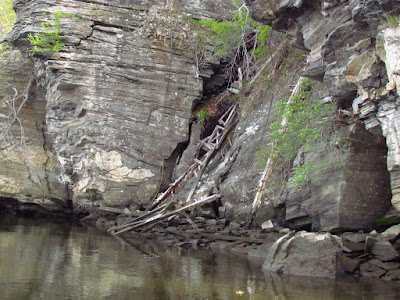The river is at the end of a mile of dusty gravel road that cuts through farm fields low enough to be replenished by very high floods, which probably don't happen much anymore.
I set out, but not until I talk some ten minutes with a guy who has pulled up in his truck. He has his binoculars out and tells me he is looking for a couple eagles, one mature and one immature, that he saw a couple days earlier. A second guy comes out of the woods with two dogs. He isn't so talkative, so I rib the dogs by asking them, "Out hunting bears?" They do not know what to say to that.
I push off and paddle straight away across the river in near dead calm, the canoe cutting through the water as smooth as it could, the paddle pulling without disturbance from wave or chop. It feels clean. It feels pure.
The air is heavy, the sky overcast. It reads as a rainstorm that is not yet here.
And then, it is behind the long island that was created by two rivers coming together, a sandbar that became a forest. The back channel is near a mile long and I find that immature eagle back there, flushing it whenever I get within 200 yards, never getting close enough for a photo.
 |
| Where the rivers meet |
I turn up the Farmington, silty shoreline edge backed by cut banks reinforced with a tangle of tree roots from trees that haven't succumbed to gravity, yet. They will, as have others. The river is deep enough to never touch bottom, but once in awhile I strike an unseen deadfall with the tip of my paddle.
 |
| weasel |
At the second bridge, a red-brown sandstone multi-arch beauty, I enter waters that I've not been in. It changes some, but not so much. Cut banks, low land, forest, forest with farm fields beyond. It is peaceful, it is regular and predictable. It is a comfort river.
The winds pick up, but they gust and die and swirl in from different directions. I return and find this section to be 2.5:1 (2-1/2 hours against the current, 1 hour on the return).
When I take out, I meet a third guy, this one also with binoculars. We talk for 30-40 minutes. He carves decoys and knows quite a bit about the local birds. It's a good talk considering we are strangers. It's something doesn't happen everywhere.







































